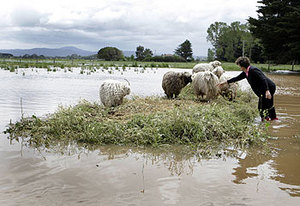Although it is hoped the same tropical system poured into the River Murray's catchment as it flooded parts of eastern Victoria, authorities are yet to determine where any run-off will go.

|
| ©Fiona Hamilton |
| Lyn Craig tends to her stranded sheep in a flooded paddock in Tinamba, Victoria, yesterday. |
Many areas from the far northwest of SA to Victoria's east have recorded up to three times the November average rainfall in the first five days of the month.
The Lower South-East recorded its wettest start to November since records began.
Mount Gambier's 127mm was South Australia's highest rainfall in the past week, while Robe received 91mm and Coonawarra received 75mm.
Pockets of the Upper North were also drenched, Booleroo Centre recording 73mm since Thursday and Melrose 67mm.
A Murray-Darling Basin Commission spokesman said engineers were analysing where the rain fell to determine flows into major storages and data should be known today.
Many towns in the river's upper catchment were soaked with 30-50mm of rain, including Lake Dartmouth where 39mm of rain fell and Albury, where 54mm was recorded.
In the capital cities Adelaide recorded 27mm and Melbourne got 36mm in the past week.
The rain in Victoria's south-east caused flash flooding in low-lying areas and people were evacuated from Tinamba and Newry.
Most homes affected by the floodwaters received only minor damage.
Although some rainfall records were broken, a Bureau of Meteorology spokesman said such weather was typical for spring.
"It is very possible to get these amounts of rainfall on one day during spring and summer, especially in summer when we can get these thunderstorms and get 100mm in a day," he said.
An SA Water spokeswoman said Adelaide's reservoirs were slightly boosted by the rain.
"Since Thursday, we have had approximately 800 megalitres of natural intake enter our metropolitan reservoirs," she said.
"This equates to an overall increase of 0.4 per cent, with our current reservoir level sitting at 81 per cent compared to 58 per cent at the same time last year."



Reader Comments
to our Newsletter